Commemorating the 150th Anniversary of the end of the Civil War
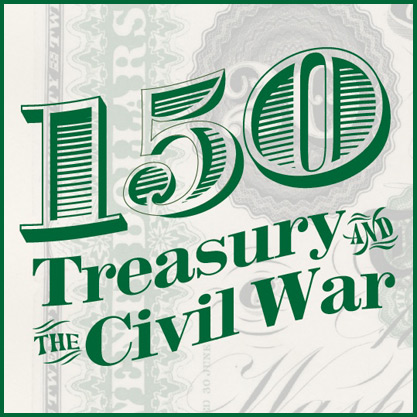
The Treasury Department has been located next to the White House since the federal government moved to Washington, D.C. from Philadelphia in 1800. The building and the Department have been a part of the history of the nation through times of triumph and crisis. During the American Civil War the building was under construction and served as a fortification in the capital against any potential Confederate attack. The nation's finances were also protected and managed to help fund the war effort.
Treasury Building, South Wing Construction

The Treasury and the U.S. Capitol buildings were the only major federal buildings in Washington, D.C. whose construction continued during the years of the Civil War (1861-1865). Building materials, manpower and financial resources were all in short supply as the war consumed the attention of the nation. While challenging, the work on the South Wing of the Treasury building neared completion just as the war began. Some of the first offices originally meant for Treasury staff were occupied by military commanders of the Union forces. As troops poured into the city, a regiment from Massachusetts set-up camp in the courtyard of the Treasury building.
Treasury Secretary Salmon P. Chase

Initially, it was hoped the Civil War would be short in duration, but as the war went on the cost of supporting the war effort was draining the finances of the nation. Serving in office throughout the Civil War, Secretary Chase was able to initiate major changes in the U.S. economy, establishing a national banking system and issuing the first federal currency, the so called "greenback" paper money.
Civil War Symbolism
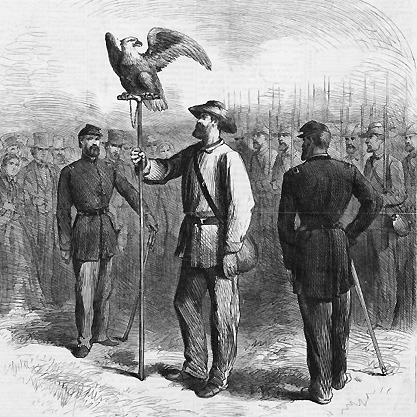
Across all manner of printed materials, currency, military flags and buildings, iconic images of eagles, the stars and stripes and the founding fathers were heavily used. On the battlefield a company of the 8th Wisconsin Infantry Regiment were inspired by the proud countenance of Abe, an eagle who was considered part of the regiment. In battle, Confederate General Sterling Price is said to have wanted to capture the eagle so badly that he stated, “I’d rather have the bird than the whole brigade!”
Civil War Currency

Beginning in 1861 the Treasury Department was authorized to begin issuing paper currency instead of minted coins as a way to help finance the Civil War. The currency notes were called "Demand Notes" because they were payable upon demand in coin. The issuing of general circulation paper currency was the first time it had been done since the Continental Currency of the American Revolution.
"Greenback" Currency
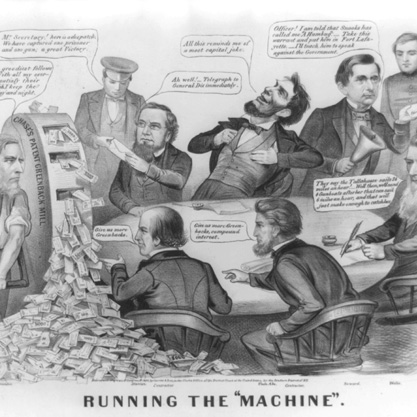
Although approved by Congress, there were conflicting points of view on the merits of the U.S. Treasury issuing a paper currency that was not directly tied to a gold standard. The tensions between the government, which needed to fund a costly war, and bankers concerned about the amount of greenback currency being issued, was frequently on display in financial publications and editorial cartoons.
Portrait of Abraham Lincoln

The Treasury Department is fortunate to have a portrait of Abraham Lincoln as part of it's Collection at the Treasury building. This particular painting of Lincoln is attributed to artist James Reid Lambdin (1807-1889). The portrait, along with one of George Washington, hangs in the offices of the Secretary of the Treasury.
The Emancipation Proclamation
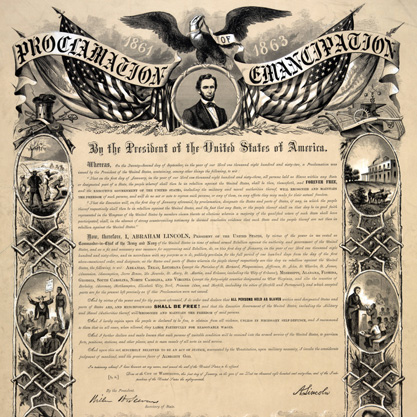
Worked on by Lincoln over a period of months in 1863, the Emancipation Proclamation declared all slaves in rebellious territory would be freed as of January 1, 1863. Essentially a presidential executive order, while the intent is clear, the complications within the document are less well known. The Emancipation Proclamation was limited, it applied only to states that had seceded from the Union. Most importantly, the freedom it promised was contingent on Union military victory. Although the Proclamation did not end slavery in the nation, it captured the hearts of millions of Americans and helped transform the character of the war. After January 1, 1863, every advance of federal troops was seen as an expansion of the domain of freedom. The Proclamation also allowed for the acceptance of black men into the Union Army and Navy. By the end of the war, almost 200,000 African American soldiers and sailors had fought for the Union and freedom.
Balcony

On the evening of April 14, 1865 while attending a performance of "Our American Cousin" with his wife Mary, Henry Rathbone, and Clara Harris, President Lincoln was shot from behind by John Wilkes Booth. The balcony box had been prepared by the theatre for the presidential party and among the flags decorating the front of the box were American and Treasury Guard flags.
Treasury Guard Flag

On the evening Lincoln attended Ford's Theatre, the presidential balcony box was decorated with American stars & stripes flags as well as those of the Treasury Guard regiment. After shooting Lincoln, John Wilkes Booth lept from the balcony to the stage below to escape, catching the spur of his boot on the Treasury Guard flag. In the chaos after the shooting at the theatre, the balcony was not secured and some of the contents, including pieces of the original flags were taken as souvenirs, lost or mistakenly identified over the years. One of the flags was only located as recently as 2001, rediscovered boxed in a collection at the Connecticut Historical Society.
President Andrew Johnson

The assassination of President Lincoln occurred only a few days after General Lee surrendered to General Grant at Appomattox Court House. When Lincoln died on the morning of April 15, 1865, vice-president Andrew Johnson became the 17th president of the United States. Treasury Secretary Hugh McCulloch offered his reception office to President Johnson as a temporary presidential office to allow Mary Todd Lincoln and the family time to move out of the White House over a period of six weeks. During his time in the office Johnson worked to calm the country, assuring visitors that he would continue to carry out the policies of Lincoln. It was also in this office that he issued a $100,000 reward warrant for Jefferson Davis, President of the Confederacy who, at the time, was suspected of involvement in the plot to assassinate Lincoln.
Treasury and the Civil War
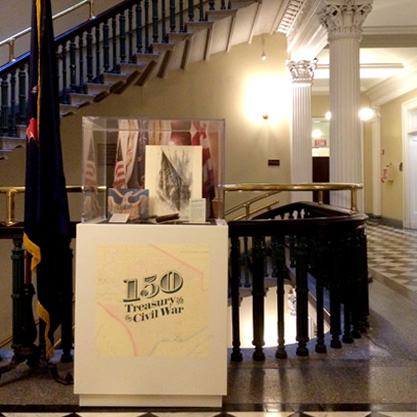
In April 2015 the Office of the Curator installed an exhibition in the Treasury Building honoring the effort of The Department and the nation on the occasion of the 150th anniversary of the end of the American Civil War. The exhibition also pays tribute to the loss of one our greatest presidents, Abraham Lincoln. Highlights of this exhibition appear here on our Treasury website and Saturday tours of the Treasury Building can be scheduled through your Congressional Office.
